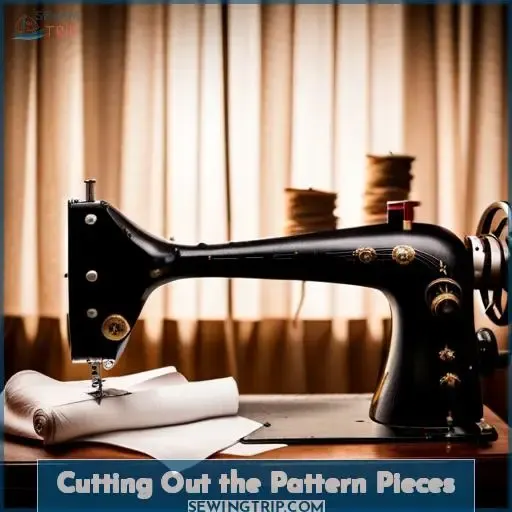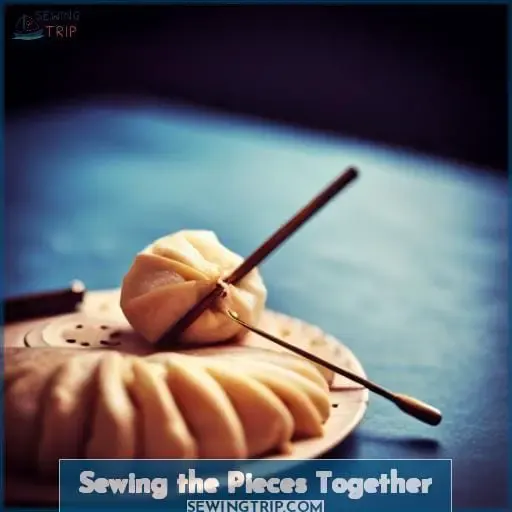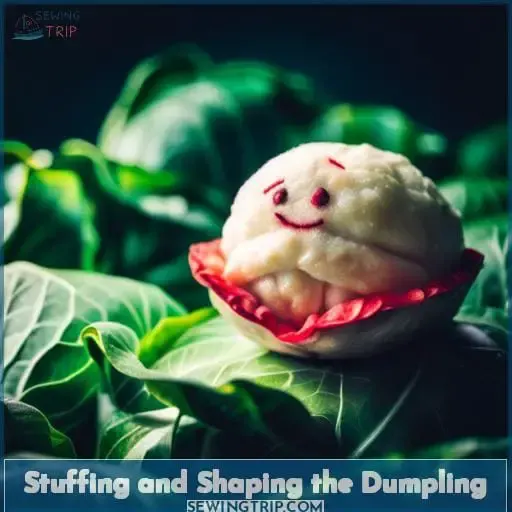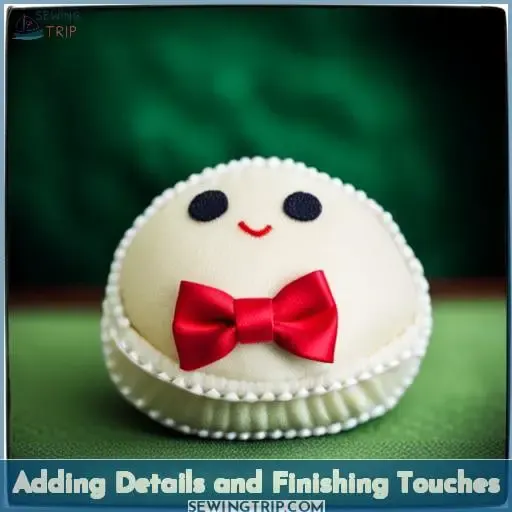This site is supported by our readers. We may earn a commission, at no cost to you, if you purchase through links.
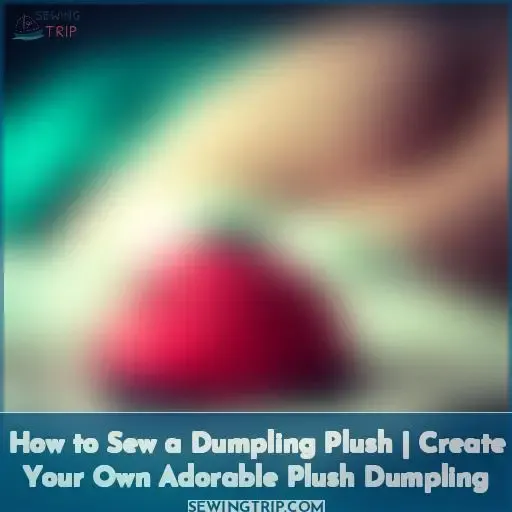 Imagine creating your own adorable plush dumpling that you can cuddle and display. With this step-by-step guide, you’ll learn how to sew a dumpling plush from start to finish.
Imagine creating your own adorable plush dumpling that you can cuddle and display. With this step-by-step guide, you’ll learn how to sew a dumpling plush from start to finish.
Choose the perfect fabric, cut out the pattern pieces, and then stitch them together using simple techniques.
Stuff and shape your dumpling just right for maximum cuteness factor.
Add those final details and finishing touches for a personalized touch that will make your creation truly unique!
So let’s get sewing – it’s time to bring this delightful little treat to life!
Table Of Contents
Key Takeaways
- Consider fabric types such as cotton, fleece, minky, felt, and corduroy.
- Choose from a variety of color and pattern options, including neutral colors, bold colors, stripes, floral prints, and plaids.
- Take care when cutting out the pattern pieces, especially around curves and intricate details.
- Use a basic running stitch to sew the fabric pieces together, backstitching for durability, and taking extra care with curved seams.
Choosing the Right Fabric
When choosing the fabric for your plush dumpling, there are a few factors to consider.
First, think about the type of fabric you want to use – whether it’s soft and cuddly like fleece or smooth and shiny like satin.
Next, explore different color and pattern options that will bring your dumpling to life.
Lastly, make sure to choose a fabric that’s durable enough for playtime adventures and easy to clean when it inevitably gets dirty from all the love it receives.
Fabric types to consider
When sewing a dumpling plush, start by considering the different types of fabric you can use.
Cotton, fleece, minky, felt, and corduroy are all great options for creating your adorable plush dumpling.
Cotton is lightweight and breathable while fleece provides warmth and softness.
Minky adds a luxurious touch with its velvety texture.
Felt offers durability and easy cutting for intricate details.
Corduroy brings a unique texture to your creation.
Choose the fabric that best suits your style and desired outcome for an intimate crafting experience.
Color and pattern options
To choose the right fabric for your dumpling plush, consider various color and pattern options that will bring your creation to life.
- Opt for neutral colors like cream or gray for a subtle and sophisticated look.
- If you want to make a statement, go for bold colors like vibrant red or electric blue.
- Stripes can add a playful touch, while floral prints offer a whimsical feel.
- For a more traditional appeal, plaids are always an excellent choice.
Durability and washability
Consider the durability and washability of your fabric choice as you continue crafting your adorable plush dumpling.
Opt for machine washable or hand washable fabrics to ensure easy cleaning.
Look for materials that are water resistant and stain resistant, allowing your dumpling plush to withstand spills and accidents without compromising its appearance.
If a fabric is dry cleanable, make sure it fits with the level of maintenance you’re willing to commit to in order to keep your creation looking fresh and new.
Cutting Out the Pattern Pieces
Now that you’ve chosen the perfect fabric for your plush dumpling, it’s time to bring your creation to life by cutting out the pattern pieces. This step is crucial in ensuring that each part of your dumpling fits together perfectly.
Grab a sheet of paper and trace the pattern onto it using a pencil or pen. Once you have traced all the pieces, grab a pair of sharp scissors or even better, use a rotary cutter on a cutting mat for precise cuts.
Carefully cut along the lines you’ve drawn, making sure not to veer off course. Take extra care around curves and intricate details. As you finish cutting each piece, pin them together with sewing pins so they stay in place during assembly.
With all your pattern pieces neatly cut out and pinned down securely, get ready for some stitching fun as we move on to our next subtopic: Sewing the Pieces Together!
Sewing the Pieces Together
Start by sewing the fabric pieces together using a basic running stitch.
Take care to keep your stitches small and even – about 1/8 inch is a good size.
Align the edges of your fabric pieces and sew them together with a consistent seam allowance, backstitching at the beginning and end for durability.
For curved seams, use small stitches and go slowly to get a smooth curve.
The whip stitch works well when closing up openings.
For invisible seams, try the blind stitch.
With a bit of practice, your hand-stitching on this adorable plushy will look clean and professional.
Stuffing and Shaping the Dumpling
You’re now ready to stuff your sewn dumpling shell and shape it into the iconic dumpling form.
- Use polyester fiberfill stuffing so it’s soft yet holds its shape
- Add stuffing bit by bit, shaking the dumpling to distribute evenly
- Stuff firmly but not too tightly or it won’t look plump
- Shape into a round dumpling as you stuff, smoothing seams
- When finished, hand sew the opening closed neatly
Adding Details and Finishing Touches
Your dumpling’s final touches bring it to life with charming details like embroidered eyes, rosy blush cheeks, and tiny felt buttons down the center.
For an extra pop of whimsy, add a ribbon bow or baker’s twine tied around its waist.
Before closing up, consider leaving a peek of stuffing to imitate tasty filling inside.
Take care stitching the edges for a lumpy, bumpy texture.
Vary your stitches – try a simple running stitch along the bottom and small, tight whip stitches along the top for fun contrast.
These special touches make your homemade dumpling unique. Customize it with colors, patterns, and decorations that show off your creativity.
Frequently Asked Questions (FAQs)
What type of fabric is best for making a dumpling plush?
For a cozy dumpling plush, opt for soft and cuddly fabrics like fleece or minky. These materials are perfect for hugging and provide a comforting touch to your handmade creation.
How do I ensure that I cut out the pattern pieces accurately?
To ensure precise pattern pieces, place your fabric flat and secure it with pins.
Use sharp scissors to cut along the lines, following the shape carefully.
Take your time and maintain control for accurate results in sewing your dumpling plush.
What sewing techniques should I use to sew the pieces together?
To sew your dumpling plush, use the whipstitch technique. It’s like tenderly stitching a hug around the edges, ensuring each piece finds its place snugly in the embrace of your creation.
How can I achieve a perfectly shaped dumpling plush after stuffing it?
For a perfectly shaped dumpling plush, make sure to:
- Evenly distribute the stuffing.
- Use small stitches to close any gaps.
- Gently shape it with your hands until you achieve the desired look.
What are some creative ways to add unique details and finishing touches to my dumpling plush?
Add a touch of whimsy to your dumpling plush by embroidering cute facial expressions using colorful thread.
Enhance its charm with tiny fabric accessories like bows or buttons, giving it that unique personality you desire.
Conclusion
Transforming a simple piece of fabric into an adorable plush dumpling is a delightful and rewarding crafting project. By following this step-by-step guide, you can create your own cuddly dumpling that’s both unique and personalized.
From choosing the perfect fabric to adding those final details, you’ll be able to bring your creation to life with maximum cuteness. So grab your sewing supplies and get ready to sew a dumpling plush that will bring joy and charm to your space.


